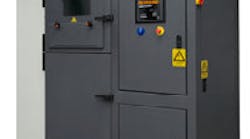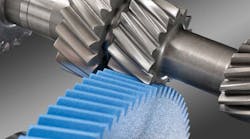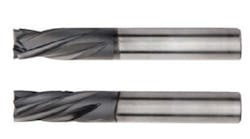Compact, high-speed Renishaw encoder mounts on clutch shaft; another fits on end of the crank shaft.
The KTM dragster, built by Salakazi Racing, makes fast, programmed take-off to burn the quarter mile in 6.7 seconds at 196 mph.
Petri Mkinen, Salakazi engineer, integrated data-capturing Renishaw encoders into the KTM dragster to optimize take-off traction. Next he wants to apply the compact magnetic encoders to ignition advance and cam adjustment.
Preparing the KTM dragster for the next race, encoder feedback allows the crew to program for optimum performance before every run.
Take one motorcycle with absurd power output, a fearless Finn with a reputation for breaking speed records, and things happen fast. Within a split second, the engine screams to 7,500 rpm. Before the spectator has a chance to comprehend what has transpired, the race is over and bike and rider are a quarter mille down the track, braking frantically. In motor racing terms, it doesn't get much simpler - traverse the straight line from A to B as quickly as possible.
Built by Finland-based Salakazi Racing and generating almost 1,500 horsepower from just 1,995cc, the KTM nitro methane dragster does the quarter mile in 6.7 seconds at a terminal velocity of 196 mph. Helping tame the KTM's (barely) controlled explosion are a brace of "bomb proof" Renishaw www.renishaw.com) RM22 compact, high-speed rotary magnetic encoders.
Jaska Salakari, the first Finn to break the seven-second barrier for the quarter mile piloting the fastest Super Twin Top Fuel bike in the European Union, owns Salakazi Racing. Since 2000, his speed-obsessed six-man team, a combination of full- and part-timers, has been running a KTM Super twin powered dragster of its own design and construction. The twin-cylinder Nitroduke engine is fueled with 95 percent nitro methane, gulping the volatile mix through a Salakazi-designed double fuel pump.
In drag racing, reaction times are measured in milliseconds, and races are never won with a wildly spinning rear wheel. All the horsepower in the world is useless unless effectively translated into rapid forward motion. For the pilot there's little or no time to think, let alone engage and slip a normal clutch. It's impossible for the rider to accurately determine the rate of engagement needed to provide optimal traction.
Salakazi Racing has equipped its KTM dragster with an automatic Prowork three-disc, four-stage clutch fitted with a Prowork digital controller. When the rider snaps open the throttle, the controller engages the clutch according to how it has been pre-programmed. That's where the Renishaw RM22 encoders with their ability to monitor up to 30,000 rpm come into play. One of the tiny but critical devices monitors the position of the crankshaft in the engine, while the other measures the clutch speed.
By comparing these values, clutch slippage, traction and road conditions can be determined with high precision. This data is highly coveted by the team and allows the technicians to properly adjust the first-stage counterweights in the clutch before the race.
Of course, track and bike conditions vary for every meeting, but the vital data collected and compiled by the Renishaw encoder after every run makes it possible to program the controller for as close to optimum clutch engagement as possible. This provides maximum speed and acceleration with minimal wheel spin during the first few fractions of a second.
Petri Mkinen - Salakazi Racing's self-confessed "technology guru" - is quick to point out that the Renishaw-enabled solution is not the same as a traction-control system. The clutch is tuned by set values programmed into the controller before the race against the clock even begins.
"The Renishaw encoder isn't interactively controlling the clutch while underway," he explained, "but the data it provides us with beforehand is critically important. We couldn't obtain it (nor preset the clutch) any other way. We need to read the clutch speed even before the rear tire completes the first full rotation, to make decisions for engaging the clutch, and the acceleration doesn't happen smoothly. This problem has now been solved and proper filtration has been done to program code."
The Renishaw RM22 encoder is designed for trouble-free performance in the harshest environments, but the Salakazi Racing Team has chosen one of the toughest of places to locate any piece of electronic equipment.
Pointing to the end of the crankshaft on a partially disassembled engine Mkinen smiles mischievously and says, "This is where we put the Renishaw magnetic actuator. We've located it directly on the end of the shaft. The encoder body is on the other side, in the clutch housing. I honestly think that only a space rocket would be a tougher environment for the encoder."
The RM22 is designed and manufactured by Renishaw's Slovenia-based partner company, RLS d.o.o. for high reliability in demanding applications and extreme environments. Non-contact designs - basically a magnet and a sensing chip - the robust, solid-state encoders feature a small actuator magnet that fits to the end of a shaft, while the Hall sensor ASIC chip is epoxy-embedded and encapsulated inside a metal housing/mount. Fully sealed to IP68, the encapsulated design provides superior resistance to shock, vibration and acc/dec forces.
While maximum operating temperature is specified as 125 degrees Centigrade, the RM22 encoder still survives the very high temperature inside the clutch. The secret, said Mkinen, is placing the encoder in the heavy, machined aluminium clutch housing and removing it fast.
"With a diameter of only 22 mm it was possible to locate the encoder in the clutch housing itself, without compromising the strength of the piece. Clutches can explode," he said, as an aside. "I've seen this happen a few times, so the clutch housing plays an important role in rider safety. If the encoder were bigger we'd have to re-engineer the solution," he noted.
"The heavy aluminium body shields the encoder from the heat during the race," said Mkinen. "After each race our mechanics cool the clutch and quickly remove the housing and the encoder. Before it ever gets a chance to heat up beyond specs, we've already got it back to the pit garage and removed it."








